About flowers, insects and networks
Nature establishes relationships between species and organisms, forming a very complex network where often great-interconnected nodes appear. They are called 'hubs'. But humans also create this kind of networks, such as airports as nodes and flights as connections.
![]()
To Nacho and Marc.
It's already winter and life slows down. The plants stop growing and flowering until spring. But reality tries to avoid clichés. I remember when in my son's nursery they decorated the classroom with autumnal motifs, then they used to ask children for garnishing materials. They expected deciduous leaves of brown or reddish colors, red fruits and pine cones picked from the ground. I prepared a bunch with rosemary and winter heather flowers. We lived in Barcelona and at that time I regularly sampled in the nearby massif of Garraf, covered by garrigue and Mediterranean pine forests. There you can find flowers in all seasons of the year. I had to insist and explain my caprice to the teachers. They put a face of artificial acquiescence. It was a school in which parents involvement was highly valued and finally my flowers participated in the exhibition. It is amazing how ideas roots in society and the cost of opening people´s eyes and minds, even to the most evident physical reality that surrounds us. However, a few years later the rosemary flowers were incorporated into the school's autumnal landscape.
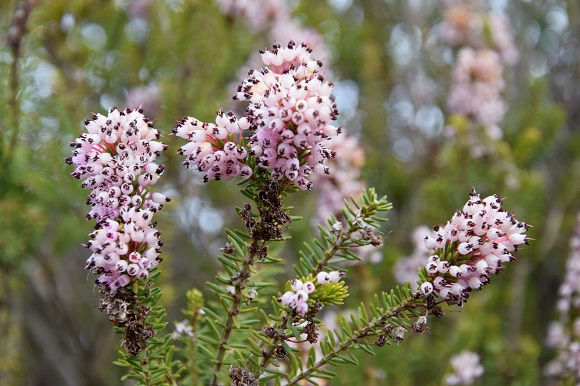
If there are flowers in winter, it is for some reason. In the Mediterranean regions, the autumn and winter temperatures are not very rigorously cold. There are insects that are able to maintain their activity in that period. Some pollinate the flowers of the few species that have chosen to continue investing in reproducing. These flowers compete to attract pollinators. Taking advantage of moments with few insects can be an advantage. In one of the studies that we were doing in Garraf, Marc Santandreu had observed that as winter progressed and the number of heather flowers decreased, the seeds set in each flower increased, even though the visits of the pollinators had decreased. So, these visits had become genetically more efficient. The genetic unit of reproduction in plants is found in the floral organs. That is, the genetic inheritance of the female and male organs varies between the different flowers of the same plant and it is at this level that the gene exchange takes place.
We can not understand flowers beauty and fragrance –and the aesthetic enjoyment that they produce on us– without the existence of pollinating insects. Angiosperm lineages found a way to increase their genetic diversity by crossing the gametes through those insect couriers. They only had to transform the leaves –petals, sepals, stamens, carpels– that surround ovules and pollen grains to make them more recognizable to insects, while rewarding them with food –nectar–. In turn, insects specialized in different floral morphologies. They took advantage of their biological cycle, compartmentalized in several stages. Adults tend to be distinctly different from larvae both in their morphology –larvae often have a wormlike form– and in their lifestyle and feeding. In the same species of butterfly, while the adult visits and pollinates the flowers, the larvae browse the leaves of other plant species. In fact, we could consider adult butterflies, with their short life, as simple providers of genetic diversity to larvae lineages that barely exceed the age of childhood, although they are majority in their number and ability to mobilize energy in the food web.
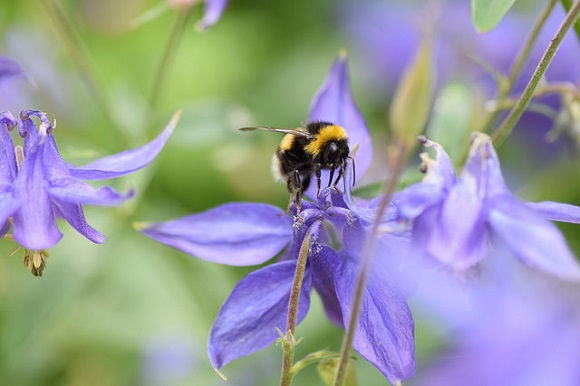
Interestingly, in the plant world, the providers of genetic diversity are the myriad of flowers that grow on a limited number of plants, which in turn captures most of the solar energy for terrestrial ecosystems. The result is that the interaction between flowers and pollinating insects –although other animals are also able to pollinate, as Anna Travesset showed with Balearic lizards– has been one of the great mechanism for genetic exchange in these ecosystems. We must recognize its success: it has been the cause of a very important part of terrestrial biodiversity. We can not understand the explosion of flowers of meadows and wetlands, bushes and forests, nor that of butterflies, bees and bumblebees and many other insects without that interaction.
But the relationships between flowers and their pollinators are really complex, much more than the simple example of heather. Not only have they promoted biodiversity, but they have also attracted the interest of biologists seeking rules in the network of the interactions between living beings. How many species of insects pollinate a specific plant species? How many different types of flowers does a certain insect species use? We can build representations of that network, and there are mathematical formulations that study them with the so-called "graph theory".
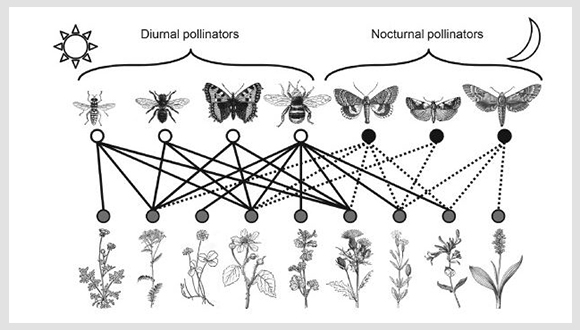
Apart from the visual effect of its representation, probably one of the most surprising things of networks are certain regularities regardless of the geographical context or the type of interrelated objects – even when they are not properly biological entities–. As a starting point, we could think of networks in which their elements -nodes- connect randomly. It would be a poorly organized system, scarcely predictable, and that does not suit our daily experience. Humans do not build our social network based on continuous fortuitous encounters. Actually, we tend to relate to a limited number of people, those that are closest to us. It would be a network structure in which we need many intermediate steps to access someone who is geographically or socially distant. The truth is that occasionally we establish direct relationship with someone distant. Years ago, we used post or occasional trips. The incorporation of a few connections to distant elements, even if random, greatly reduces the steps necessary to access any node in the network, giving rise to what is called the "small world" network. One of those surprising rules of the networks indicates that six is the approximate magical number of steps that allows reaching any point in large networks such as those generated by human societies.
If the fact of establishing connections implies some benefit, it will tend to favor connections with those nodes that serve as a link between distant parts of the network. That avoids the necessity of each node to invest in many long-distance connections. As a result, we will have the network structured on the basis of very connected nodes, such as airports "hubs". Therefore, we will have a few nodes with many links and numerous nodes with a reduced number of connections. Interestingly, it is the same pattern that we find in biological diversity, with few species with many individuals and numerous species with few individuals.
Returning to pollinators networks, we can recognize the existence of generalist species (with many connections, that is, they visits to many different flowers) and specialists (with few connections, that is, they prefer a very few types of flowers). In general, it is observed that specialist pollinator insects visit plant species that are also visited by generalist insects. That is, specialized insects tend to establish a relationship with generalist flowers. Conversely, specialized plants tend to be visited by generalist insects. This phenomenon is called "nestedness". It seems that it helps to make the network more robust, since specialized insects, which would be more vulnerable, depend on reliable plant species, since they in turn are less dependent on the visits of a few pollinators. The relationship between specialist pollinators and specialist plants tends to disappear because when one of them fails, the other can not persist.
The interest in understanding the functioning of these networks transcends the world of natural history, since we see that their laws are the same as those governing social networks of communication or economic exchanges. The advent of computers and remote access with few restrictions on other computers has therefore revalued the study of networks and their properties, which had already been addressed by mathematicians. One of the peculiarities of the web is that long distance connections have almost zero cost. What at first sight may seem an advantage, also represents a loss of structure, and therefore of efficiency, independently of the advantages of more equal peer access. So we need for intermediaries –the "hubs"– that structure and, thus, hierarchize the connections of the network.
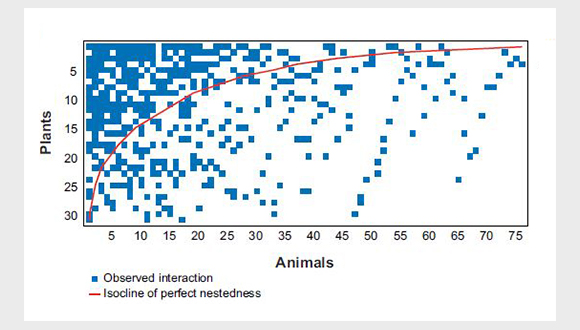
Not by chance, the system itself has been structured based on search engines that drive a large part of these connections. Its success is based on the brute force of algorithms that analyze the frequency of connections, feeding back future links. In essence it is the mechanism that favours the appearance of "hubs", as seen before. Even so, the criteria to establish preferred connections are many and the linear list of results generated by a search engine often is not very useful. We end up using thematic filters, or the search engine itself decides for us and puts us in the forefront of the list those issues that are most frequently searched, which use to involve commercial transactions –hotels, trips-. They in turn constitute the basis of the business . Thus, in reality, the network is also thematically structured, compartmentalizing it.
Modularity is another property of networks as we also find it in ecological ones. We say that a module or compartment is constituted by a set of nodes -species- that are more related to each other than with the rest of the nodes of the network. In a network of pollinators and plants this modularity could be determined, for example, by the existence of certain floral morphologies that restrict the number of possible pollinating species.
Although the study of networks seems to focus on the interactions, it is important to keep in mind that these interactions would not exist without the nodes, and that these are defined as discrete units. This is very important. Interactions networks are constructed in contrast to other ecological models that are based on the continuous nature of matter and energy flows, without identifying discrete units. For example, in order to establish the water in a watershed, we need to know the sources or inputs, mainly by precipitation, and the losses, by evapotranspiration, infiltration in the subsoil and river transport, but we do not need to establish discrete study units that are interconnected. We can not ignore that life is organized in discrete units, organisms, and this concerns the deep nature of life. The biological structures self-organize and remain in time, eluding the maximum entropic disorder that determines the laws of thermodynamics, thanks to its ability to dissipate energy. The construction of membranes and filters that delimit the biochemical environment is the first step of this self-organization. Without that energy component, the discrete nature of life would not be explained. In fact, in ecology there is a long tradition of synthesis between an approach based on the flow of energy and matter and another that analyzes the selective response of organisms and species. This synthesis materializes in trophic networks, with their different levels of producer and consumer species –also called predators–.
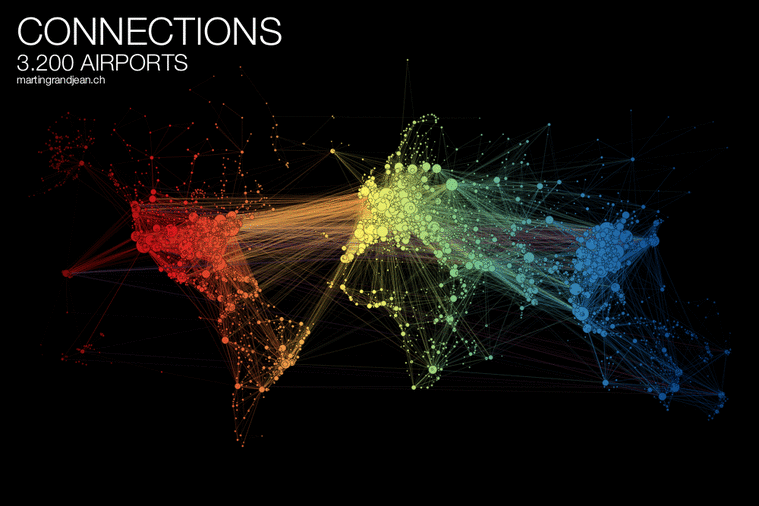
Networks of interactions based on the mathematical properties of nodes and connections, such as those that describe pollination mutualisms have not yet sufficiently incorporated the energetic nature of the interactions. The study of networks follow a holistic approach, by providing descriptors of the whole network, regardless the detail of each component. But the study of networks is also subject to considerations of scale and there is a growing interest in capturing the variability within the nodes, which in our example has hitherto corresponded to plant species and pollinators. By incorporating this within node variability, the energetic implications and the physical constrictions of the interactions between nodes will likely be incorporated into the analysis.
We finish with an example. We can build a network of interactions between the world's airports by using the flights that connect them. Extremely connected nodes that structure the network appear. But ultimately, the reason that limits the ad-infinitum growth of hubs connectivity is the size of the aircraft and the space needed to move them without collisions and for passengers to travel to the aircraft. This translates into the connection time between flights. If this period is very long, it will end up promoting connections in another alternative airport. It is not enough to draw a map of connections if we do not also introduce the energy cost-benefit and the physical dimensions of real objects. Again, we need to leave the computer screens with their infographics and the pre-established mental models to walk through the physical world and contemplate the autumn flowers in their eagerness to hear the whisper of bumblebees.







